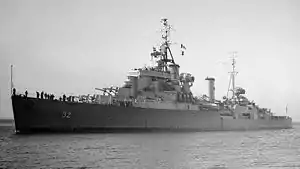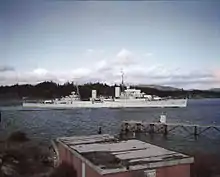HMCS Ontario (C53)
HMCS Ontario was a Minotaur-class light cruiser built for the Royal Navy as HMS Minotaur (53), but transferred to the Royal Canadian Navy on completion and renamed Ontario.[2]
 HMCS Ontario in 1951 | |
| History | |
|---|---|
| Name: | Minotaur |
| Builder: | Harland & Wolff, Belfast |
| Yard number: | 1171 |
| Laid down: | 20 November 1941 |
| Launched: | 29 July 1943 |
| Fate: | Transferred to Royal Canadian Navy in July 1944 |
| Name: | Ontario |
| Acquired: | July 1944 |
| Commissioned: | 25 May 1945 |
| Decommissioned: | 15 October 1958 |
| Motto: | "Ut incepit fidelis sic permanent" (Loyal she has been and remains so)[1] |
| Fate: | Scrapped, arriving at Osaka for breaking up on 19 November 1960 |
| General characteristics | |
| Class and type: | Minotaur-class light cruiser |
| Displacement: |
|
| Length: | 555.5 ft (169.3 m) |
| Beam: | 63 ft (19 m) |
| Draught: | 17.25 ft (5.26 m) |
| Propulsion: |
|
| Speed: | 31.5 knots (58.3 km/h) |
| Range: |
|
| Complement: | 867 |
| Armament: |
|
| Armour: | |
HMS Minotaur was laid down on 20 November 1941 by Harland & Wolff of Belfast and launched on 29 July 1943.[2] She was transferred to the Royal Canadian Navy in July 1944, and completed and commissioned as Ontario on 25 May 1945 at Belfast.[2][3]
Service history
After commissioning she was worked up on the River Clyde in Scotland. She sailed to join the 4th Cruiser Squadron in the Pacific Theatre, but was too late to see active service, although she was employed in the operations at Hong Kong, Manila and in Japan. She returned home for refit, arriving at Esquimalt, British Columbia on 27 November 1945.[3]
In October 1948, Ontario was joined by the destroyers Cayuga, Athabaskan, Crescent and the frigate Antigonish in sailing to Pearl Harbor, Hawaii; the largest deployment of the Royal Canadian Navy following the war.[4] In January 1949, Ontario took part in the largest training cruise by the Royal Canadian Navy to that date which included the aircraft carrier Magnificent, the destroyers Haida, Athabaskan and the frigate Antigonish. The group, designated CTF 215, participated in naval exercises with US and British vessels in the Caribbean Sea.[5][6] In February 1951, Ontario sailed to Australia, taking part in joint naval exercises with the Royal Australian Navy. On the way the ship made several port visits, returning to Canada in June.[7] In October 1951, Ontario sailed to the east coast where after arrival, Princess Elizabeth and Prince Philip, Duke of Edinburgh sailed on the cruiser from Sydney, Nova Scotia, through the Cabot Strait to Newfoundland during the Royal Visit. The ship returned to Esquimalt following the tour, arriving in December.[8] From September to December 1952, Ontario sailed around South America on a training cruise, making several port visits.[9] While entering the harbour at Buenos Aires, the cruiser was overtaken by the merchant vessel SS Arauco and struck amidships. The ship continued on her cruise until arriving at Rio de Janeiro on 6 November. There it was found that the starboard propellers were damaged. The outer propeller was removed and repairs were made to the inner one. After nearly two weeks at Rio de Janeiro, Ontario was forced to return to Esquimalt at a reduced speed.[10]
On 15 June 1953 the cruiser took part in the Fleet Review to celebrate the Coronation of Queen Elizabeth II.[11][12] In January 1954, Ontario began a training cruise across the Pacific, visiting Australia, New Zealand and Tonga before returning to Esquimalt in April.[13] Ontario performed a three-month training cruise to Australia and New Zealand in early 1955, returning to Canada on 2 April. The cruiser then departed on 25 April for a four-month cruise of Europe.[14] In June 1956 Ontario departed Esquimalt for a two-month summer training cruise along the coasts of North and South America, going as far south as Ecuador. The cruiser returned to port on 10 August after meeting the Second Canadian Escort Squadron off the coast of California.[15]
Ontario was paid off on 15 October 1958.[3] The ship was sold to a west coast firm which began but did not finish the job of breaking up the ship at Vancouver. The ship was resold, along with HMCS Quebec to Mitsui and Co. of Japan.[16] She arrived at Osaka for breaking up on 19 November 1960.[2]
Ship's bell

The ship's bell of HMCS Ontario is currently held at HMCS Ontario Cadet Training Centre in Kingston, Ontario. The second bell is held by the Maritime Museum of British Columbia. The Christening Bells Project at Canadian Forces Base Esquimalt Naval and Military Museum includes information from the ship's bell of HMCS Ontario, which was used for baptism of babies on board ship.[17]
Later use of the name
On 13 July 1981 Royal Canadian Sea Cadet Camp Frontenac was renamed Ontario Sea Cadet Training Establishment located in Kingston, Ontario, Canada, at the Royal Military College of Canada. In later years Ontario would be redesignated as HMCS Ontario Sea Cadet Summer Training Centre.
Effective 2015 all training centres were redesignated to a standard format, Ontario is now designated as HMCS Ontario Cadet Training Centre.
References
Notes
- Arbuckle, p. 80
- "HMS Minotaur (53)". uboat.net. Retrieved 27 March 2014.
- Macpherson, Ken; Burgess, John (1981). The ships of Canada's naval forces 1910-1981 : a complete pictorial history of Canadian warships. Toronto: Collins. ISBN 0-00216-856-1.
- "Plenty of Seatime". The Crowsnest. Vol. 1 no. 1. King's Printer. November 1948. p. 2.
- "Going Down South". The Crowsnest. Vol. 1 no. 4. Queen's Printer. February 1949. p. 2.
- "Spring Cruise Starts". The Crowsnest. Vol. 1 no. 5. King's Printer. March 1949. p. 2.
- "Ontario Making Long Cruise to Antipodes". The Crowsnest. Vol. 3 no. 4. King's Printer. February 1951. p. 2.
- "Ontario Making Return Voyage to Esquimalt". The Crowsnest. Vol. 4 no. 1. King's Printer. November 1951. p. 2.
- "HMCS Ontario to Make South American Cruise". The Crowsnest. Vol. 4 no. 11. Queen's Printer. September 1952. p. 2.
- "Damaged in Collision, Ontario Homeward Bound". The Crowsnest. Vol. 5 no. 2. Queen's Printer. December 1952. p. 3.
- Souvenir Programme, Coronation Review of the Fleet, Spithead, 15th June 1953, HMSO, Gale and Polden
- "RCN to Take Part In Coronation, Review". The Crowsnest. Vol. 5 no. 4. Queen's Printer. February 1953. p. 2.
- "Ontario to Honour Queen Again". The Crowsnest. Vol. 6 no. 2. Queen's Printer. December 1952. p. 2.
- "Training Cruisers Return Home". The Crowsnest. Vol. 7 no. 6. Queen's Printer. April 1955. pp. 3–4.
- "Summer Training Keeps Ships Busy". The Crowsnest. Vol. 8 no. 10. Ottawa: Queen's Printer. August 1956. p. 2.
- "Cruisers Bought by Japanese Firm". The Crowsnest. Vol. 12 no. 11. Queen's Printer. September 1960. p. 3.
- "Christening Bells". CFB Esquimalt Naval & Military Museum. Archived from the original on 30 December 2009. Retrieved 27 March 2014.
Sources
- Arbuckle, J. Graeme (1987). Badges of the Canadian Navy. Halifax, Nova Scotia: Nimbus Publishing. ISBN 0-920852-49-1.
- Beard, Jonathan D. & Schleihauf, Bill (2001). "Question 24/00: Canadian Naval Mutinies". Warship International. International Naval Research Organization. XXXVIII (3): 243. ISSN 0043-0374.
- Colledge, J. J.; Warlow, Ben (2006) [1969]. Ships of the Royal Navy: The Complete Record of all Fighting Ships of the Royal Navy (Rev. ed.). London: Chatham Publishing. ISBN 978-1-86176-281-8.
- Macpherson, Ken; Burgess, John. The ships of Canada's naval forces 1910–1981 : a complete pictorial history of Canadian warships. Collins: Toronto, 1981. ISBN 0-00216-856-1